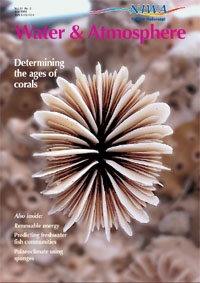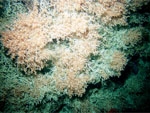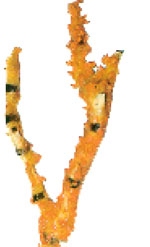PDF of this article (7 MB)

Di Tracey Helen Neil Dennis Gordon Steve O'Shea
How old is a coral? Finding the answer requires some rather complex steps.




The seas around New Zealand support a rich and diverse range of corals. Some deep-sea species – found to depths of at least 2500 m – can be incredibly long-lived, with ages ranging from decades to hundreds of years. These include both stony corals and the less well-known octocorals. Rapid changes in their environment (such as those caused by fisheries, as well as changes in climate and ocean patterns) can have significant impacts on these animals. To identify and reduce these effects we must understand both the taxonomy and biology of deep-sea corals. At NIWA we are investigating ways to learn one of the basic pieces of information: the age of individual specimens of coral. The work so far shows that it is possible to get a good idea of the age of a coral, but it is not easy.
Problems in age measurement
Corals come in all shapes and sizes. This means that no single method can be used to measure the age or growth rate of all coral types. For example, the conventional technique of ageing by counting concentric growth zones – as in fish otoliths (ear bones) – could be used for some coral species, but not for colonial, tree-like corals.
Because corals grow by depositing a calcium carbonate (calcite) skeleton, radiocarbon dating could provide estimates of ages. In corals the method is complicated by two very different sources of carbonate in the skeleton: from the adjacent water and from the coral’s diet. We need to explore the processes of growth and metabolism and determine the age of surrounding water and levels of carbon before we can accept coral ageing methods with confidence.
The calcium carbonate that forms on the new tips of corals is in balance with the surrounding water. However, the mixing of ocean waters of different ages and the delay in exchange between the atmosphere and the ocean cause the level of natural radiocarbon (14C) to vary. This mixing is known as the marine reservoir effect. The radiocarbon ages of the newly formed coral tips provide the known radiocarbon signature or the “reservoir age”. If we can find out more about the age of deep-sea waters in our region then we can also find out the age of the coral. (The ages of water masses are available from temperature records, including historical sea-surface temperature data.)
Both coral growth and levels of 14C are affected by climatic events, including El Niño cycles and changes in sea-surface temperature. We can use environmental records and the known rate of transfer of radiocarbon from the atmosphere into deep water to interpret the age and growth of corals.
Ageing coral becomes even more difficult if the coral’s diet includes carbonate. However, little is known currently about feeding in deep-water corals.
Ageing methods
We have searched the scientific literature to determine what techniques are available to age corals and to validate these ages. Apart from radiocarbon dating (see above and “Radiocarbon dating and bomb radiocarbon” below), methods include other radioisotope techniques and transverse section counts. Validation can be achieved either by bomb radiocarbon signatures or in-situ growth-rate studies. Our biological collection has several samples of deep-sea coral species we can use for ageing studies and further samples will be collected during future marine surveys.
Stable isotopes and climatic records
The environmental conditions corals have been exposed to during their life are locked in their carbonate matrix, and can be unravelled by using stable isotope techniques. For example, changing stable isotope ratios of oxygen can indicate past ocean temperatures, while metabolic processes such as respiration influence the stable isotopes of carbon. We are using high-resolution historical temperature records derived from coral to provide insights into seasonal and interannual variability and multidecadal climate cycles. This information can help explain the variability of growth zones, and the bursts of growth (or slow growth), all of which help determine the age of the coral.
Radiometric age validation
Radiometric assessment measures the proportion of radioisotope pairs found in calcified structures such as fish otoliths and corals, and gives a close estimate of age. Elements such as radium and thorium enter an organism through normal metabolic processes, and reach their half-life after a known number of years. The ratio of 210Pb/226Ra is used to calculate age for potentially long-lived organisms (that is, more than 60 years old).
Growth-zone counts
The age of some species of coral can be estimated by counting skeletal growth zones along the coral stem (a technique similar to preparing otoliths). X-rays of the slices cut from the growth axes can be fluoresced to make it easier to count the zones.
Previous work
In preliminary work at NIWA in 1999, we aged samples of bubblegum coral (the gorgonian Paragorgia arborea – photo left). The colony tip of this coral was dated at between 100 and 200 years old and the base was between at least 300 and 500 years old. Another New Zealand gorgonian, bamboo coral (family Isididae, Keratoisis sp., photo left) was also dated at between 300 and 500 years. In Australia three ageing methods – growth zone counts, radiocarbon dating, and radium and thorium radiometric ageing – were used to age two colonies of Keratoisis. Although none of the methods aged the corals precisely, the consensus was that they were between 100 and 150 years old.
The Primnoidae is the least well known of New Zealand’s gorgonian families. Although no New Zealand species have been aged, branches of small colonies overseas have been aged at about 112 years by using Lead-210 (210Pb). Scientists sampled thin sections along the axis of the skeleton of the red tree coral Primnoa resedaeformis in the Gulf of Alaska and found the ages along the sections ranged between 8 and 105 years.
Other work on New Zealand deep-sea stony corals has reported radiocarbon ages for several species including Madrepora oculata (photo left) and Enallopsammia rostrata (photo left). Ages ranged from under 200 years to more than 6000 years. For comparison, a study of the same species in the North Sea found ages ranging from 600 to 5000 years.
Complex steps to ageing
Studying the age and growth of coral is complicated. We need to understand: the source of carbonate (how much comes from the ocean and how much from metabolism); the effects of climatic events; how to interpret growth zones; the effect of 14C and biological processes such as feeding and reproduction; and how to overcome the lack of deep-sea environmental data records. We also need to find out where on the coral we should be sampling to get the best estimates of age. At the moment we know little about how deep-sea corals deposit their calcite, but we will be exploring this further so that we can have greater confidence in our age estimates.
To confirm and validate age and growth, it will be necessary to use a combination of some of the possible methods for ageing coral. In addition to ageing the corals, this work should yield a high-resolution record of ocean temperature during the past 100 years by using stable-isotope signatures preserved in the corals’ carbonate skeletons.
Teachers: this article can be used for NCEA Achievement Standards in Biology (1.2, 2.2, 2.6), Physics (1.2, 2.2, 2.5, 2.7), Chemistry (1.2, 2.5). See other curriculum connections at www.niwa.co.nz/pubs/wa/resources
Di Tracey, Helen Neil and Dennis Gordon are based at NIWA in Wellington; Steve O'Shea is based at the Auckland University of Technology.
Our work ageing corals is part of the FRST-funded programmes “Seamounts: their Importance to Fisheries and Marine Ecosystems” (C01X0224) and “Consequences of Earth–Ocean Change” (C01X0203).
Definitions
Kinds of coral
Gorgonian: Half of all New Zealand’s octocoral species (see below) are gorgonians (fan corals, Order Gorgonacea). Gorgonians have a central axial rod and a calcareous skeleton, which accounts for the yellow, orange, or lavender colours in some species.
Octocorals: Octocorals are recognised by their polyps, which typically have eight tentacles, and virtually all form colonies. New Zealand’s octocorals are very diverse, but only 40 of at least 133 species have been identified with certainty.
Stony corals: “True” corals (Order: Scleractinia) that build reef-like structures. They are closely related to sea anemones but produce a calcium carbonate skeleton. Some are solitary and comprise a single polyp (e.g., cup corals) but most are large and are made up of branching colonies of interconnected polyps. Currently 127 species are known in New Zealand.
Ageing techniques
Half-life: The time it takes for half of the original amount of a radioactive element to decay. 14C has a half-life of 5730 years.
Radiocarbon dating, bomb radiocarbon: See “Radiocarbon dating and bomb radiocarbon” below.
Stable isotopes: Stable isotopes are non-radioactive isotopes of elements, which occur naturally in the environment. Their ratios alter as they undergo physical, chemical and biological changes. For over 20 years coral skeletons from temperate regions have been used to reconstruct records of isotopic and chemical ratios in seawater. (For more on stable isotopes, see Water & Atmosphere 7(2): 22–28.)
Radiocarbon dating and bomb radiocarbon
The 14C radiometric dating method is based on 14C decay. It relies on the principle that a proportion of natural carbon in the atmosphere (as carbon dioxide) is the radioactive isotope 14C. (Ordinary carbon has a molecular weight of 12.) Natural atmospheric radiocarbon levels have been modified by human activities (fossil fuel combustion, nuclear power plants and testing). As a result the oceans have undergone a significant input of radiocarbon that is clearly visible in 14C time-series derived from measurements of seawater or by using proxies such as corals or bivalve shells.
The amount of radiocarbon incorporated in the hard parts of marine organisms such as bivalves, corals, and fish (for example, shells and otoliths) can be measured. This is a well-known dating method and is used to age coral species both in New Zealand and overseas.
Atmospheric testing of nuclear devices during the 1950s and 1960s created a global signal of 14C that can be traced in atmospheric, terrestrial, and marine environments. Bomb radiocarbon quickly became incorporated in the carbonate of hard tissues (coral skeletons, fish otoliths) in concentrations proportional to those in the water column. The level of 14C in hard tissues can determine whether the corals were growing before, during, or later than the main years of 14C increase (1958–65), using appropriate reference 14C chronologies for the region. Ages previously determined from growth increment counts can be shown to be either correct or incorrect and so this is a powerful validation procedure.
